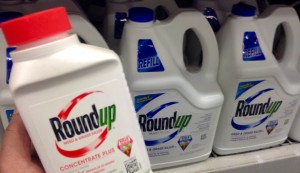28
Feb
Study Confirms Findings on Carcinogenic Glyphosate, Suggests “Compelling Link”
 (Beyond Pesticides, February 28, 2019) Earlier this month, a team of U.S. scientists published a meta-analysis of studies on glyphosate-based herbicides (GBH), concluding that the evidence “suggests a compelling link between exposures to GBH and increased risk of NHL [non-Hodgkin lymphoma],” corroborating findings by the International Agency for Research on Cancer. The analysis, authored by researchers from University of California, Berkeley, University of Washington, Seattle, and the Icahn School of Medicine at Mount Sinai, New York, is the latest to support the conclusions established by the International Agency for Research on Cancer that products containing glyphosate pose a cancer risk to humans. As research continues to accumulate on the risks posed by this chemical, the case for transitioning to less toxic alternatives to safeguard public health is becoming increasingly urgent.
(Beyond Pesticides, February 28, 2019) Earlier this month, a team of U.S. scientists published a meta-analysis of studies on glyphosate-based herbicides (GBH), concluding that the evidence “suggests a compelling link between exposures to GBH and increased risk of NHL [non-Hodgkin lymphoma],” corroborating findings by the International Agency for Research on Cancer. The analysis, authored by researchers from University of California, Berkeley, University of Washington, Seattle, and the Icahn School of Medicine at Mount Sinai, New York, is the latest to support the conclusions established by the International Agency for Research on Cancer that products containing glyphosate pose a cancer risk to humans. As research continues to accumulate on the risks posed by this chemical, the case for transitioning to less toxic alternatives to safeguard public health is becoming increasingly urgent.
Researchers took every available published human study on NHL and glyphosate, including the most recently updated data from the ongoing U.S. Agricultural Health Study (AHS), in conducting their review. Focus was put on individuals within these studies exposed to the highest amounts of glyphosate. The reasoning, researchers indicate, is that if there is a true association between glyphosate and a health outcome like cancer, exposures to higher amounts for a longer period of time is most likely to reveal this link. Higher exposures are also less likely to present concerns with confounders and other statistical interference. The study authors indicate this is the same approach that has been employed to estimate risks for chemicals like benzene and formaldehyde, but no similar analysis has been conducted on glyphosate.
Statistical analysis revealed there to be a 41% increased risk of NHL resulting from high exposure to glyphosate-based herbicides. To compare and add weight to their results, researchers also conducted a second statistical analysis using older (2005) AHS data, which surprisingly revealed a higher, 45% risk.
“This paper makes a stronger case than previous meta-analyses that there is evidence of an increased risk of NHL due to glyphosate exposure,” said co-author Lianne Sheppard, PhD, a professor in the Environmental and Occupational Health Sciences department at the University of Washington to the Guardian. “From a population health point of view there are some real concerns.”
Dr. Sheppard participated in the U.S. Environmental Protection Agency’s advisory council on the agency’s review of glyphosate’s carcinogenic potential, and joined other advisors in a letter to the agency stated it did not follow proper scientific methods. “It was pretty obvious they didn’t follow their own rules. Is there evidence that it is carcinogenic? The answer is yes,” Dr. Sheppard told the Guardian. “As a result of this research, I am even more convinced that it is.”
As is typical of destructive and outdated industries, agrichemical giant BayerMonsanto has worked to teach the controversy to its pro-pesticide advocates, with brazen attempts to muddle the science, or scuttle official inquiries into glyphosate’s safety.
There is strong evidence that BayerMonsanto had ghostwritten research on glyphosate (Roundup) that was later attributed to academics, according to a New York Times report on Monsanto’s internal emails. There is now an investigation by the Inspector General for EPA into whether or not an EPA official engaged in collusion with Monsanto regarding the agency’s safety assessment of glyphosate by working to kill a separate evaluation on glyphosate from the US Department of Health and Human Services. The collusion was uncovered in the discovery phase of a lawsuit filed by cancer victims that link their illness to glyphosate exposure.
Online trolls and disinformation campaigns waged by the chemical industry continue, which often influences public opinion. Independent scientific studies are critically important during this period. There is strong evidence of glyphosate’s carcinogenic properties, and more reason than ever to get active in your community to eliminate not only its use, but the whole range of toxic synthetic herbicides and pesticides in favor of less toxic alternatives. Contact Beyond Pesticides for assistance in organizing your community, including strategies and model policies that can work to replace toxic pesticide use.
For more information about glyphosate and its danger to health and the environment, see Roundup Causes Cancer, Roundup (Glyphosate) Exposed, and Beyond Pesticides general fact sheet on Glyphosate.
All unattributed positions and opinions in this piece are those of Beyond Pesticides.
Source: Reviews in Mutation Research (peer-reviewed journal), The Guardian, UW News (press release)










